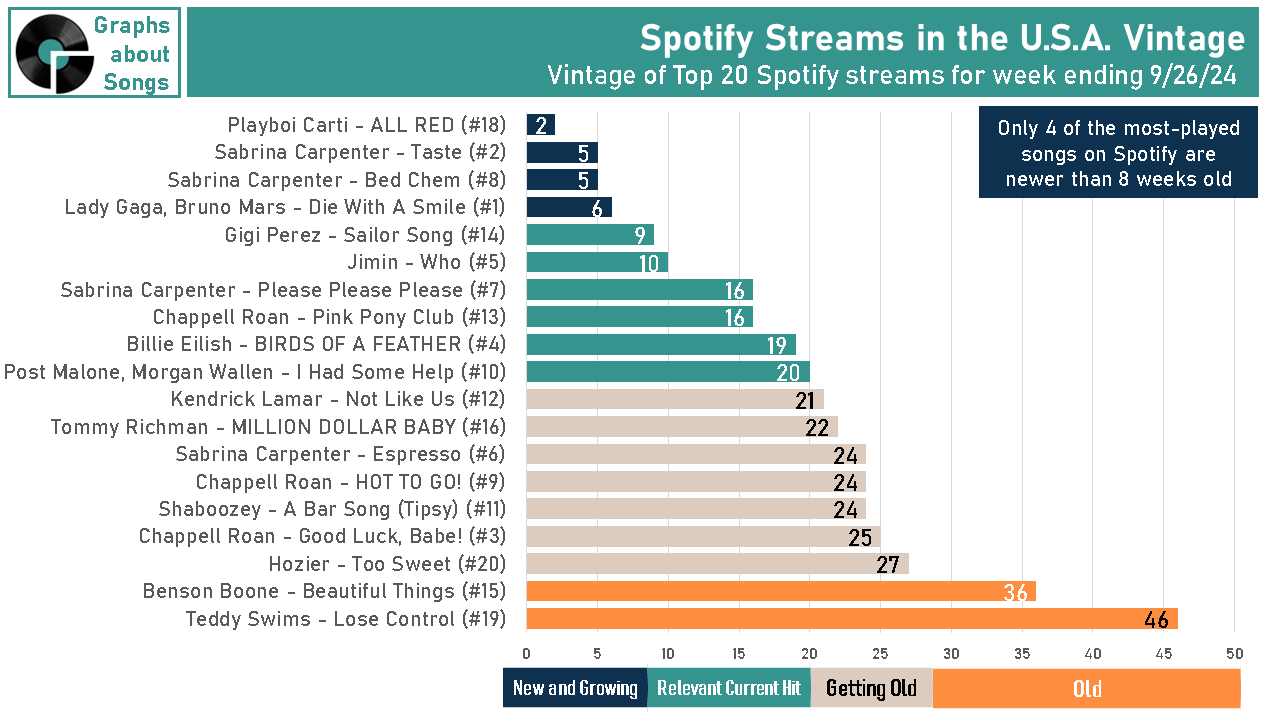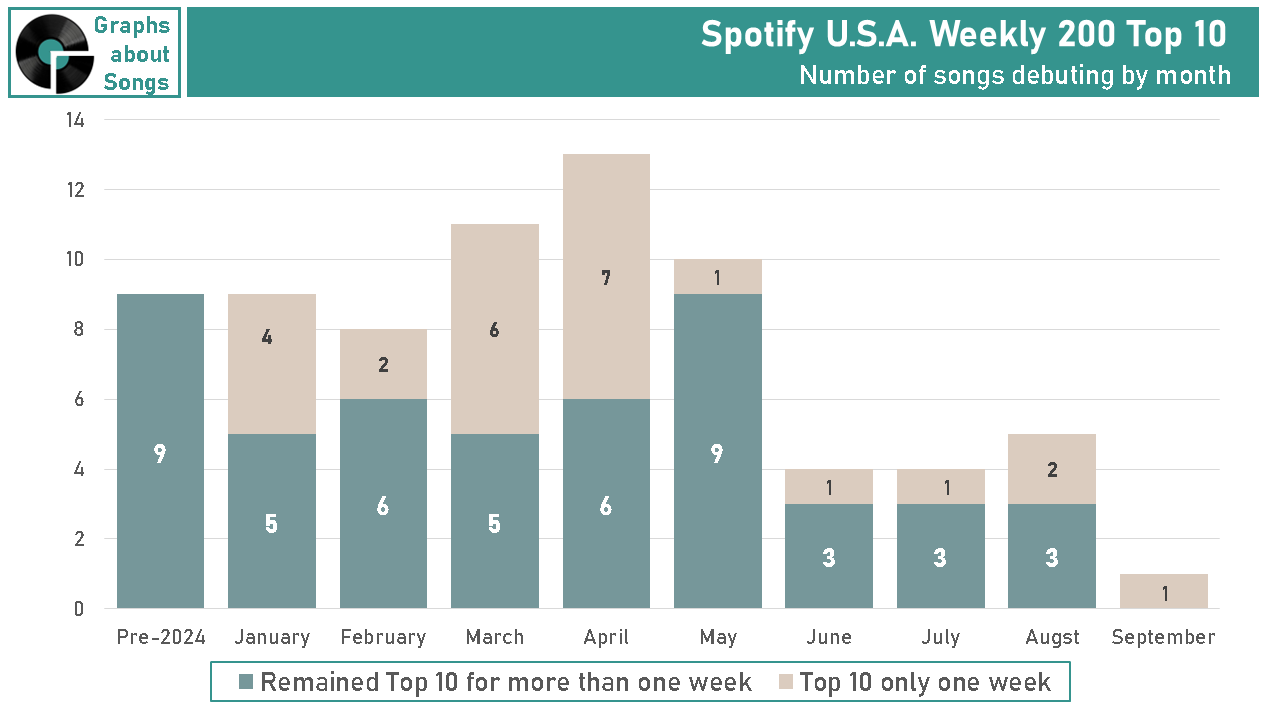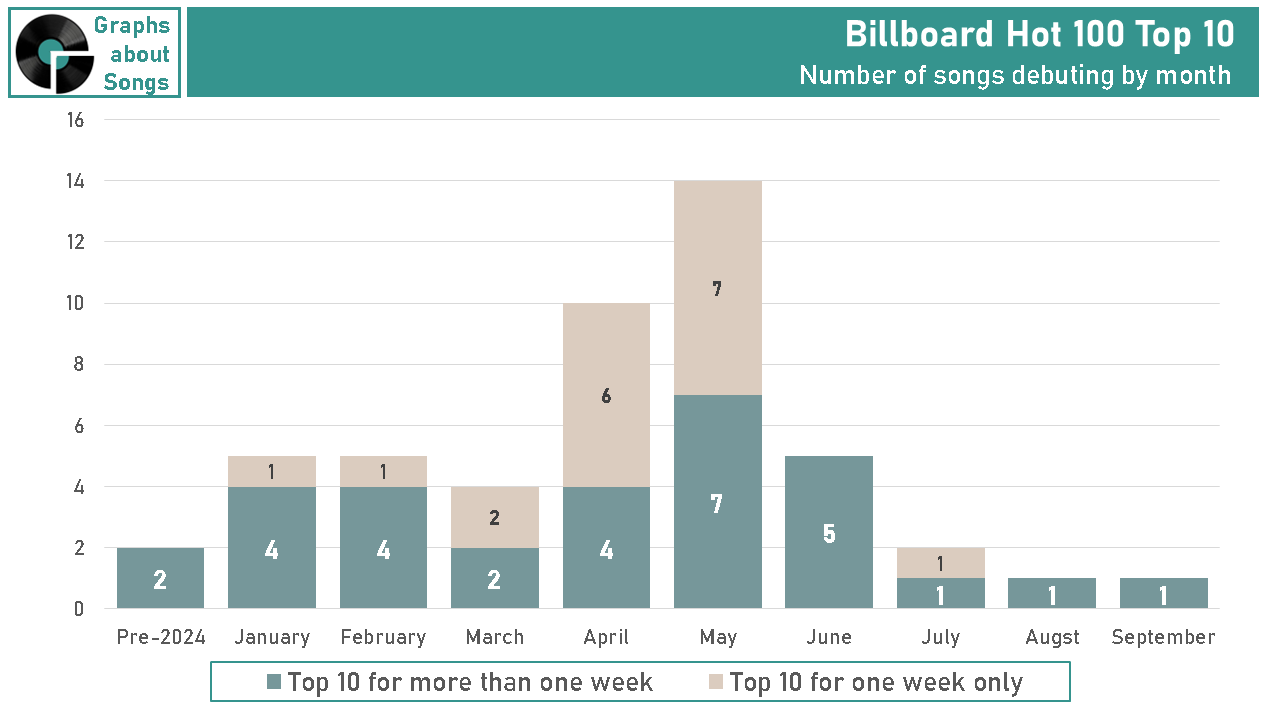Where Did 2024's Great New Hits Go?
Back in June, 10 exciting, mass-appeal hits topped the Billboard Hot 100. By September, most of the same songs were still the biggest hits. Are we ignoring big hits, or did they really all dry up?
When Summer ’24 began, legendary radio personality and music guru Gene “Bean Baxter (He was half of Kevin & Bean on the World Famous KROQ in L.A.) took a look at the Hot 100 chart in Billboard magazine and declared:
“This is the best US Billboard Top 10 in ages and by that I mean it’s filled with actual hit songs, not just big artist debuts. Fight me.”
No one fought him. The Top 10 for the week ending June 22nd included two straight up Pop hits from 2024’s breakout star Sabrina Carpenter, two country-crossover Summer bangers, Teddy Swim’s genre-blending Power Ballad, and Kenrick Lamar’s Drake take-down.
It looked like the beginning of a steady stream of exciting new mass-appeal hit music.
Fast forward three months to this Fall. Seven of those songs are still among the chart’s Top 10. Chappel Roan’s “Good Luck, Babe”, which was already charting in June, climbed its way into the Top 10 in July. That leaves only two songs released after the start of Summer have reached the Top 10:
One is the fifth Sabrina Carpenter song vying for your attention.
The other is an Adult Contemporary ballad from veterans Lady Gaga and Bruno Mars
This chart shows the same Top 10 of the Hot 100 (week ending October 5th, 2024), showing how many weeks each song has been on the Hot 100 as of the end of September:
Are the next batch of hits hiding in plain sight? Does the stagnant Top 10 stem from radio stations simply sticking with the same proven songs way too long? Or, is there really an unprecedented lack of new releases good enough to replace all those songs that debuted last Spring?
Let’s get to the bottom of the case of the disappearing new hits.
Radio’s biggest hits are running out of time
Here are the dozen songs America’s hit music stations played most during the last week of September. This first graph simply looks at how many times America’s hit music stations played their Top 12 songs:
The next graph sorts these same 12 songs based on how long they’ve been hits, which I’m defining as the week they first appeared on the Spotify 200 chart. I’ve color-coded each song based on how old it is using criteria informed by both radio airplay data and my 15 years of analyzing new music research:
New and Growing: In general, it takes about eight to ten weeks for causal music fans to become familiar with a new song and ultimately grow to love it. Radio stations typically play these “new and growing” songs less often until they know their listeners are going to love it.
Relevant Current Hit: Assuming listeners like a song, they’ll have the strongest passion for the song and perceive it as a relevant hit that folks are talking about when the song has been charting for nine weeks to between 20 and 28 weeks
Getting Old: Depending on the song, listeners will perceive that a song is no longer a relevant hit sometime between 20 and 28 weeks. They may stop liking it or they may love it for decades, but they are starting to think of it as a passe song.
Old: At this point, listeners don’t think of this song as today’s music. Radio stations rightfully still liberally sprinkle these songs into their mix as recent favorites, but if you claim they’re a “hit”, you sound dumb.
Of the dozen songs radio played most last week, all but three of them have already surpassed the 20-week mark where listeners start thinking of songs as “old” ones. The remaining three are less than a month from that mark.
Is radio ignoring new hits?
Our next graph shows the songs Americans have played most on Spotify during all of 2024 (by how many millions of times they’ve played this year). You’ll notice those songs that radio is playing most mirror this list—the only song not currently among radio’s top songs spent months topping radio airplay.
In other words, there’s no massive hit here that radio is ignoring.
Okay, but what about the songs Spotify users are playing right now?
As I’ve explained in pedantic detail in a previous Graphs About Songs, streaming inherently amplifies consumption of brand-new releases since its where an artist’s fans go to sample their latest songs. So surely we’ll see plenty of songs that dropped recently that could be on their way to replacing Tipsy, right? RIGHT?
Here are the most-played songs on Spotify for the last week of September:
Simply from scanning the song titles, you’ll see that many of the songs your local hit music station is playing most right now are still among the songs Americans are playing most when they’re in control of their music.
Let’s now look at that same list of Spotify’s most-played songs for the last week of September. In this graph, however, the order is based on how many weeks each song has been in Spotify’s Top 200. I’ve color-coded each song based on vintage criteria I explained above.
Notice that only four of the most-played songs on Spotify for the week are less than eight weeks old. (“Is that Typical,” you ask? Hang on… that graph will be here soon.)
With that context, let’s now look at the same songs, still denoted by weeks on the chart, but this time color-coded based on how much radio is playing these songs
Four songs are indeed receiving radio airplay. However, radio plays these songs a bit less often than they do the established hits:
Sabrina Carpenter – Taste
Lady Gaga, Bruno Mars - Die With A Smile
Jimin – Who
Chappell Roan - HOT TO GO!
While all of these songs already perform as mass-appeal hits on Spotify (as I show in The Hit Momentum Report for programming professionals), all but one are still new enough to be “new and growing” among radio listeners.
I could make a case here why radio needs to be more aggressive with new releases now that streaming has made it massively easier to sample new songs. I can also point to a past where successful stations aggressively promoted new music, What I can’t argue, however, is that it’s illogical that the songs the most people know and love are the songs the radio should play most.
That leaves us with just four songs hit music stations generally aren’t playing—all but one with logical reasons:
Playboi Carti - ALL RED is only two weeks old, didn’t debut that high, and is the kind of pure Hip Hop track that often doesn’t attract fans beyond the genre partisans. (Indeed, this week’s Hit Momentum Report shows very little mass appeal pot entail for “ALL RED.”
Sabrina Carpenter - Bed Chem is streaming like the album cut hit. With five other Sabrina songs already hits, where would radio play a sixth one?
Chappell Roan - Pink Pony Club would be the third current from Chappel Roan
That leaves only one song that is a proven hit on streaming that radio is largely ignoring: Gigi Perez’s “Sailor Song,” the folksy sensual song that went vral on TikTok and has developed a cult following.
In conclusion, the lack of new hits is not because radio refuses to embrace streaming hits. If radio trusted streaming data, “Sailor Song” would be in rotation and—assuming the song does indeed appeal to a mass audience—it could replace one of those months old songs still hanging in the Top 10.
One song.
So we can’t blame radio stations for sticking with the same old songs here. The fact is, streaming is suffering, too.
Is Streaming hiding the hits?
How typical is a September where the most-streamed songs are months old? Is it really all that unusual to only have four songs that are less than two months old among the Top 20 most streamed songs when Fall starts?
Let’s quantity. The graph below shows how old the typical Top 20 songs on Spotify are in a given week by year, from 2019 to 2024:
For any given week during the last five years, almost half the songs are “New and Growing” (1 to 8 weeks old), six are “Relevant Hits (from 9 to 20 weeks old), about two are at risk of “Getting Old” (21-28 weeks), and the remaining two or three songs are definitely songs listeners now think of as “Old” (29 or more weeks old).
The number of “Old” songs typically in the Top 20 each week grew a bit from 2019 to 2023, but has retreated in 2024.
Now, let’s examine each individual week from April through September in 2024:
At the end of April 2024, all 20 Top 20 songs were new songs. That’s the week Taylor Swift dropped The Tortured Poets Department and took over 18 of the top 20 spots. (The only two non-Swift songs that remained in the Top 20 that week, Hozier’s “Too Sweet” and Sabrina Carpenter’s “Espresso”, were still new in April.)
Starting in May, however, the number of “New and Growing” songs in Spotify’s Top 20 each week steadily dropped most weeks. By mid-June, new songs slipped below the average level. With only one week’s exception, it’s stayed well below average.
Meanwhile in September, the number of songs that are in the 21 to 28 weeks old vintage where people typically start perceiving a song as “old” has grown to 7 out of 20 songs—typically only two of the Top 20 songs are that old.
One final graph to remove all doubt that this lack of new hits isn’t normal. This graph shows the typical vintage of Spotify’s Top 20 songs by month.. Half of the 20 most-played songs on Spotify in August and September (2019-2023) are typically less than two months old. Only four newer songs among the Top 20 simply isn’t normal. The only month that you can expect to be different is December, for which we have Christmas music to blame.
Bottom line… 13 of the last 15 weeks from mid-June through the end of September have had fewer new songs than average. Without those new songs, the last four week have had more songs that are on the cusp of people considering old.
One final pair of graphs to emphasize the issue here. First, here are the number of songs that first reached Spotify’s Top 10 each month. Most of those songs debuted in the Top 10.
The only new song released since late June that’s spent more than a solitary week in Spotify’s Top 10 that we haven’t already discussed is Morgan Wallen’s “Lies Lies Lies.”
None came out in September.
Now, let’s review the number of songs that entered the Billboard Hot 100’s Top 10 each month so far in 2024.
Those songs that debuted big on Spotify in the first few months of 2024 became established hits later in the spring, pushing them into Billboard’s Top 10 during May and June. With few new songs debuting, however, there simply haven’t been hardly any new Top 10 hits emerging since July.
Does the lack of big new hits hurt us?
As radio consultant and music guru Sean Ross noted when he discussed this problem, several Contemporary Hit Radio (CHR) stations that saw promising ratings growth earlier this year lost those gains in the most recent ratings surveys.
Streaming statistics makes the correlation even clearer.
Between January and April 2024, the total number of times someone played a Top 200 hit on Spotify each week rose from around 600 million to 800 million.
During the last week of April, Taylor Swift almost single-handedly added an additional 400 million plays each week.
Then from mid May to the end of September, the total number of times people played a Top 200 hit on Spotify fell from around 1 billion to under 800 million.
When there are more new songs that are exciting to a mass-appeal audience, people consume more new music.
So where did the hits go…?
I got bupkis.
I have plenty of data to show you how “A Bar Song (Tipsy)”, “Good Luck, Babe!” and “Not Like Us” garner more passion from more people than most songs we’ve seen this decade.
I can even show Spotify data that supports why radio should be championing Gigi Perez’s “Sailor Song” and should stop being afraid of Jimin’s “Who.” (That’s exactly what you’ll see in The Hit Momentum Report.)
But I don’t work for a record label. I’m not involved in talent development.
The best theory I can offer you here is that perhaps the best songs of 2024 so far are simply much harder to beat than what we’ve heard in recent years.
… and when are they coming back?
What I can predict is that those next exciting hits are coming… eventually.
We’re on the cusp of Generation Z overtaking Millennials as the primary consumers of new music. Just as 1983 gave us Thriller and New Wave, and just as 2003 gave us Crunk ‘n’ B, 2025 is poised to be a year of new and exciting evolution in the styles of popular hit music.
There is hope that we can move beyond “Tipsy” before everybody at the bar is blackout drunk.
Sources for this post:
The Billboard Hot 100: https://www.billboard.com/charts/hot-100
Wikipedia’s Billboard Hot 100 Top 10 singles: https://en.wikipedia.org/wiki/List_of_Billboard_Hot_100_top-ten_singles
Mediabase - Published Panel - Past 7 Days: http://www.mediabase.com/mmrweb/fmqb/charts.asp?SHOWYEAR=N
Spotify Charts (2019-2024 for the USA): https://charts.spotify.com/charts/overview/us

















